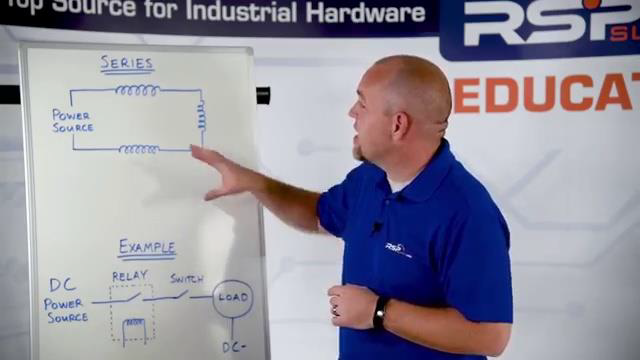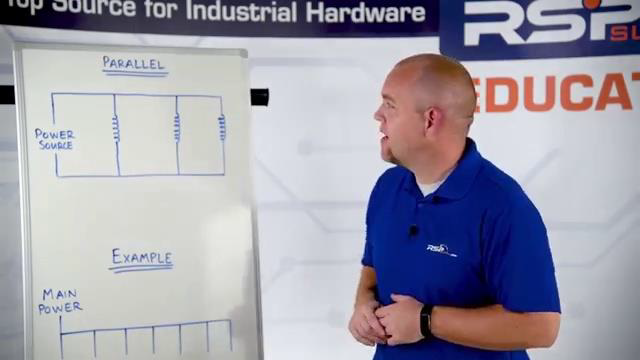Series_vs__Parallel_Circuits.pdf
Series vs Parallel: Better understand the differences
Series Circuits
- In a series circuit has only one path for electricity to flow
- Every component on that circuit will affect the overall current level of that circuit
- The more resistors that are added to a series circuit, the less the current level will be
- If the circuit is open at any point, every component will lose power on the circuit
Parallel Circuits
- In a parallel circuit electricity will have multiple paths in which it can flow
- Each component can see varying degrees of current depending it's locations and resistance in the circuit
- The more components that are added, the higher the current draw will be
- Parallel circuits allow for a component to become disconnected or open while still allowing other components to remain energized
Usage Scenario
Think of a set of light bulbs: In a series circuit the more light bulbs that are added, the more dim the light bulbs will shine. Also, if anyone of the those light bulbs are disconnected or broken, all other bulbs on that circuit will no longer function. In a parallel circuit, the bulbs will not dime even if many bulbs are added, however, there will be a larger current draw the more that get added. Also, if any bulb is disconnected, there other bulbs will not be affected and will continue to function.
Transcript:
[0m:4s] Hi I'm Josh Bloom, welcome to another video in the RSP Supply education series. In today's video, we are going to be discussing electrical circuits. More specifically, we are going to be looking at the difference between series circuits and parallel circuits. We will show the main differences between these two types of circuits and the advantages and disadvantages of each. Remember that when talking about electrical circuits, there needs to be a closed loop in which electricity can flow through the whole circuit, starting at the power source and returning to the power source or ground.
[0m:40s] Let's first talk about circuits that are wired in series. In a series circuit, the current passing through the circuit will go through every component on that circuit one at a time.
[0m:54s] Because of this, every component or resistor on the circuit will experience the same amount of current.
[1m:1s] So, the more resistance that is added to a series circuit, for instance, if we add more components, the less current you will see in that entire circuit.
[1m:11s] Also, the voltage drop across the entire circuit will equal the sum of the voltage drop on each component in that circuit. One of the most defining characteristics of a series circuit is the fact that current has only one path in which it can flow. Because of this fact, if at any location the circuit is opened, every component on that circuit will lose power until the circuit is closed again.
[1m:41s] This can be caused by a failure of one of the components on the circuit or simply the removal of a component on that circuit.
[1m:48s] An example of this might be a set of light bulbs in our home. If these light bulbs are wired in series, that is to say each one is wired directly to the next, if one light bulb fails or if it is unscrewed, the rest of the light bulbs will no longer function in this circuit until the problem is fixed.
[2m:7s] Also, the more light bulbs that are added to this circuit. The less bright each bulb will shine because of the added resistance and decreased current in that circuit. Wiring in series is very common in many applications. In industrial applications, it can be used as a sort of switching device to make sure that a circuit is not closed and fully energized until everything on that circuit is in the proper state.
[2m:35s] These can be switches or relays and various other components, all wired in series acting as a sort of safety. Once all the components are in a certain state, in this case closed, the circuit will be energized allowing current to pass through it, allowing the desired result to occur. For example, you might be starting a large motor.
[2m:58s] Wiring in series in this manner gives you added safety and control in electrical circuits you wish to govern in many industrial applications. Let me show you an example of a few different types of series circuits. As you can see here, we have a very simple example of a series circuit. We have our power source with multiple resistors on this circuit. You can see that the current will have to pass through each resistor on this circuit. Again, this is a very simple example of a series circuit.

[3m:28s] Down here, you can see the example we talked about in the industrial application where we have power that eventually is going to be powering our motor. It needs to pass through a relay and a switch before the motor will actually be energized. Once the relay is closed and the switch is closed, power can pass through and the motor can turn on. Again, this is a great safety measure to ensure that the motor does not start unless we absolutely want it to. Now let's talk about parallel circuits. In a parallel circuit, you will see the same amount of voltage drop exists between all the components that are wired in parallel. However, unlike a series circuit, which we will see the same amount of current pass through each component, the parallel circuit will have different amounts of current passing through each component depending on that components resistance. The sum of all the components current that are in parallel will equal the total current for that circuit.
[4m:28s] One of the most defining characteristics in a parallel circuit is that electricity will have more than one path in which to flow. Because of this fact, if one or more components in the circuit fails or is disconnected, the other components wired in parallel will continue to function normally.
[4m:47s] Let's use the same light bulbs example as we did before.
[4m:52s] If we wire several light bulbs together in parallel, that is to say each bulb will have its own path for electricity to flow, if one bulb fails or is removed, the rest of the bulbs will continue to function properly.
[5m:6s] Also, the number of bulbs added to the circuit will have no impact on how brightly the bulbs will shine. However, the more bulbs that are added to the circuit, the higher the current draw will be on your power source. As with series circuits, parallel circuits can be used in many different kinds of applications. One specific industrial application that you see commonly is used in industrial control panels. When distributing power to the different devices within the industrial control panel, it is common to see those devices wired to the main power bus in parallel. This allows each device to receive the necessary power that is needed for it to run properly without depending on other devices to ensure that power is being provided.
[5m:52s] Because of the added current draw from multiple devices within the panel wired in parallel, it is important to make sure that the circuit protection is sized properly to accommodate the power requirements for all the different devices on that circuit. So, let me show you a few examples of those parallel circuits that we're talking about.
[6m:10s] Here you can see a very simple parallel circuit. We have our power source with multiple resistors. You can see that each resistor has its own path for electricity to flow.

[6m:23s] So, if one resistor fails,
[6m:26s] the others will continue to function properly.
[6m:28s] Down here, you can see the example that we talked about. In an industrial control panel, we have main power coming in and we distribute that power in parallel to all the different devices within the panel. So, to quickly recap, in a series circuit, electricity has one path that can travel on. If any component on that circuit fails or is removed, the remaining components in that circuit will no longer function or be energized until the problem is fixed. On a parallel circuit, each component will have its own path for electricity to flow. This allows components to continue to function even if one of the components on that circuit is removed or fails. With this type of circuit, however you will see increased power consumption.
[7m:14s] For a full line of industrial electrical components or thousands of other products, please go to our website. For more information or other educational videos, go to RSPSupply.com, the Internet's top source for industrial hardware. Also, don't forget: like and subscribe.




